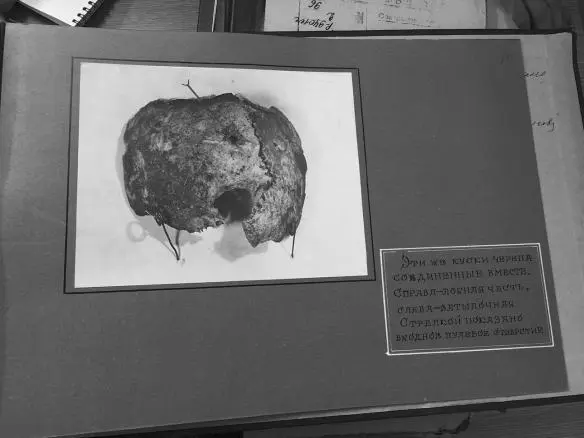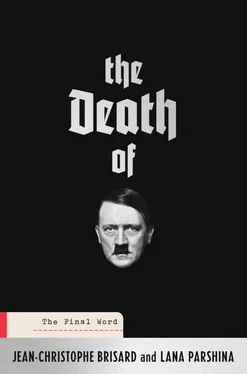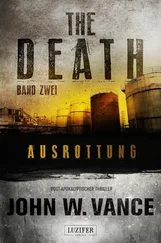Dina would have to live with that secret for decades. She wouldn’t be able to travel abroad, she would be under the surveillance of the authorities and wouldn’t be able to change jobs. As a result she spent forty years in the same service, wasting away amid dusty documents that no one could consult. “Our department was called the ‘Department of the Secret Collection,’” she goes on. “The only things kept here were confidential files. And there was no question of declassifying anything. None of the staff of this department were able to talk about anything they did. Even among ourselves, we didn’t talk about the documents of which we were in charge. There was no communication between one floor and another.”

Photo of the skull believed to be Hitler’s in a photo album at GARF.
The dashing septuagenarian pursues her mission just as diligently as always. Dina no longer really understands the new rules of her country. Declassified, reclassified–which documents are accessible? She’s a bit lost. “The last time I was able to speak openly about that skull was in the early 1990s. My superiors suddenly opened up all our doors to researchers. There were historians, and then, very quickly, journalists turned up. A lot of journalists. And that’s where everything got complicated.” An article published in the Russian daily Izvestia on 19 February 1993 marked the start of a crisis. “I’m holding in my hands the remains of Hitler’s skull,” the journalist Ella Maximova wrote. “They are preserved amidst conditions of the greatest secrecy in a cardboard box labelled ‘blue ink for fountain pen,’ along with some blood-stained fragments of a sofa that was in the bunker.” She was the first to reveal the scoop. The news was immediately picked up all over the world. For many years, there were rumours claiming that the KGB had not destroyed the Führer’s body, but had kept it hidden somewhere in Moscow.
And then a national newspaper confirmed that the legend was partly true. But wasn’t the skull a fake? Mightn’t it be one of those manipulations of which the Russians were so fond? Western historians immediately declared their fury. They stated categorically that all of this was impossible. Hitler’s skull? What nonsense. Meanwhile the foreign press got very excited. They wanted to see. In this Russia recently freed from its Communist trappings, money dictated the rules. Anything could be bought, anything could be sold, everything had a price. Including Hitler’s skull? Some people said yes. Tension mounted when the correspondent of the German magazine Der Spiegel said he had been offered access to the bones and five interrogation files from eyewitnesses of the last days of Hitler for a large sum of money. And not in roubles. The Russians had been too greedy, and Der Spiegel preferred to withdraw from the auction. “We wouldn’t have given half of what they were demanding,” [3] The Independent , 20 February 1993, Helen Womack.
the magazine’s Moscow correspondent explained at the time.
“Those articles harmed us a lot,” Dina says. “The journalists… saying that we didn’t want to show the skull, that we were asking for money, that’s all false. It was in order to prove it that our authorities decided to organise a big exhibition about the end of the war and display Hitler’s final remains.” With the success that we know about. New scandals about the identification of the skull, and then the decision by the Russian authorities to put the object back in its safe and not let the journalists get anywhere near it. “Of course everyone wants to know if it is really Hitler.” Nikolai can’t conceal the faintly irritated expression that never leaves his face. “You want to study the skull, analyse it, why not? I know it’s his. I know how Hitler killed himself. I’ve read all the dossiers from the investigation. From 1945, when the inquiry began, it’s all there. But if you want to start again, go ahead.” Is that the answer, at last, to all our questions? Is this strange archivist conveying his director’s decision to us? “Can we carry out tests on the skull? Is that it?” Dina and Nikolai look at one another. They are both reluctant to speak. “Our task is to keep the archives in the best possible condition so that future generations can consult them. We don’t have to carry out scientific experiments.” Nikolai doesn’t give a clear answer. Lana points this out as politely as possible. He replies in the same monotonous, reedy voice. “None of these questions concerns us.” A smile. Hold that smile, even if it’s starting to look a little tense. Given her age and her long history in this post, it’s Dina we should be concentrating on if we want to get that important reply. “I imagine that’s possible, yes,” she says at last. When? How? Through whom? So many parameters to be determined, so many points to be illuminated. We can come back very quickly with an important specialist. We’ve chosen him. He knows all about it. “His name?” Nikolai asks. “You know him, we’ve told you all about him in our emails. His name is Philippe Charlier. A Frenchman. He is a qualified medical examiner. Very well known in France. You must know him. The identification of the skull of Henry IV: that was him.”
We’ve made an agreement. Lana talks to the two archivists to confirm once and for all what they have just told us. In the meantime I avidly consult the files that Nikolai has taken the trouble to bring with him. They are the reports by the Soviet secret services into the disappearance of Hitler. Unusually, I am given permission to take photographs of them. “All of them?” I ask. Nikolai says yes. I don’t hold back. I take pictures of everything. Dina looks at me out of the corner of her eye. I can see that she’s uneasy. She’s not happy about a foreigner freely taking pictures of her precious documents. She hovers around me, murmuring a few words in Russian. I don’t understand a word and that suits me fine.
She goes on repeating the same words. I go on. All of a sudden she loses her temper and calls Lana, who is still talking to Nikolai. She talks agitatedly to my colleague, pointing at me with her finger. Lana turns towards me, slightly panic-stricken: “You’ve got to stop. You’re only allowed to take ten photographs. No more than that!” I pretend not to hear her and go on. Now Dina is really shouting at Lana. Why ten? I try to gain some time and pretend to be surprised. Nikolai said I could take as many as I liked. “That’s just how it is,” Lana replies. “She thinks ten is enough.” How can I be cross with dear Dina? She has spent her whole professional life guarding these secret documents. Forty years protecting them from prying eyes, and you can’t just delete something like that. I imagine the shock she must feel seeing me, a Frenchman, a capitalist, pillaging the treasure trove of her professional life right in front of her eyes. She reacted too late; I’ve finished. I’ve got photographs of everything. The Hitler files are now in the memory of my smartphone. Several hundred pages to translate and digest. A painstaking job.
PARIS, OCTOBER–NOVEMBER 2016
The first translations of the documents photographed in the offices of GARF came in quite quickly. Lana has worked wonders. She prefers to send them to me in the evening, after her day’s work. Apart from this investigation into Hitler, she is still freelancing for the Russian media. For my part, I’ve gone back to France. I’m classifying the translated texts by subject and date. Some remain quite obscure. So many unknown names and obscure acronyms clogging up the administrative phrases. The Russian investigators hadn’t much time for poetry. Their work was dictated by efficiency and precision. Here’s one of the first documents I’ve been given:
Читать дальше













